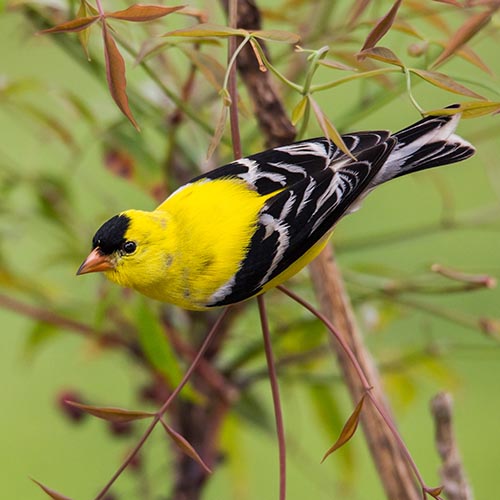
I remember Dad hanging our first tube feeder on the front porch. He filled it from a special bag of seed, not the sunflower seeds that we fed to all the other birds that came to our feeders during the winter. These were much smaller and elongated – “thistle seeds” he called them.
I silently wondered, “Will I have to watch out for more thistles when I run barefooted through the yard next summer?”
The tube feeder and thistle seeds were supposed to attract goldfinch. We already had some goldfinch coming to our feeders to eat the sunflower seeds with the other birds, but these new feeders were supposed to be just for finches.
It was fun watching the goldfinches eat out of the tube feeders. I especially enjoyed it after we got the feeders that reduced house finch use by requiring the birds to hang upside down to reach the ports. I mean, how can you not enjoy watching a bird hang by its toes to eat? I remember wishing I could do that because it looked like it would be fun.
Eventually, I learned that the “thistle seeds” we filled the feeder with weren’t the same thistles that pricked my feet in the summer. Instead, what we fed the goldfinch were Nyjer seeds. Today, I rarely hear Nyjer seeds referred to as thistle seeds. I’m guessing because my little kid brain wasn’t the only one that thought of the prickly plants with purple flowers when it heard “thistle.”
As I’ve learned more about goldfinches, I’ve come to enjoy and appreciate these bouncy, feathery balls of sunshine even more. They have some fairly unique nesting and feeding behaviors which I find fascinating. And because I understand those behaviors, I can easily attract and watch flocks of goldfinches virtually all year long.
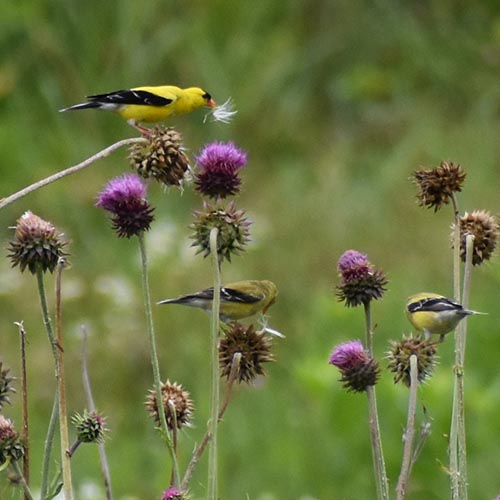
Where to find American goldfinches
Range
There are three species of goldfinch in North America, but the American goldfinch (Spinus tristis) is the most widespread. In much of its range, the American goldfinch is the only species of goldfinch found there. In those areas, the “American” part of their name is often dropped, and they are commonly referred to as just “goldfinches.”
American goldfinches can be found throughout most of North America during at least part of the year. In the northern most part of their range, they are only present during the summer. While in the most southern portion of their range, they are only present during the winter. However, in the middle portion of their range (where I live), they are present year-round.
Habitat
American goldfinches like semi-open areas – habitats that have trees and shrubs surrounded by lots of seed producing flowers and grasses. They are a common visitor to feeders in the winter and will happily co-exist at other times in urban and suburban locations that have the proper habitat for them.
How to identify the American goldfinch
Male
During the breeding season, the male is a bright, sunshine yellow with a jet black forehead, wings, and tail. There is also a white patch on its rump, both above and below the tail. The bill is orange during the breeding season.
Early in the spring, the wings have bright white wing bars (horizontal stripes). The tail will also have some bright white stripes. These bright white stripes on the wings and tail fade as the season progresses so that by the end of the summer the wings may look solid black.
During the non-breeding season, the male’s colors are much duller and more closely resemble those of the female. Non-breeding males also lose the black patch on their forehead and their bill is dark grey or blackish.
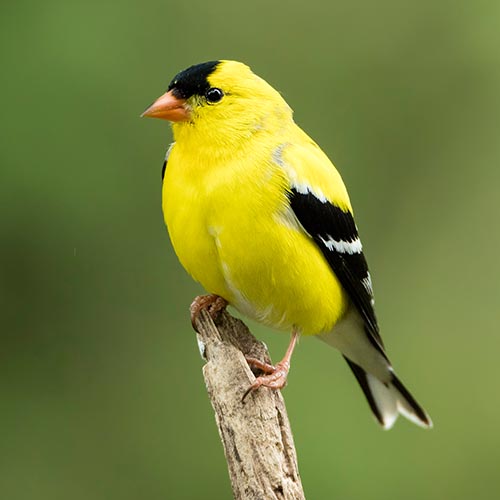
Female
Female American goldfinches are much duller in coloration than the males. During the breeding season, they are kind of a lemony yellow or a greenish-yellow color with their back being darker than their front. Their wings and tail are black with some white stripes, but the black isn’t nearly as dark as the male’s wings and tail. They also lack the black forehead patch of the male.
Like the males, female American goldfinches have an orange bill during the breeding season. Research has shown that the color of the female’s orange bill helps to determine the female pecking order in flocks of goldfinches. Females with duller bills tend to give way to females with brighter bills.
During the non-breeding season, the female’s colors become duller and may even take on a yellowish-brown tone. The bill of non-breeding females is also a dark grey or blackish color that is similar to the non-breeding males.

Immature
Immature American goldfinches, or young-of-the-year, are a warm tannish or light brown color. Their wings and tail are black, but the black isn’t as dark or as striking as that in the wings and tail of a breeding male.
In Flight
The American goldfinch has a distinctive “bouncy” or wave-like flight pattern. When they flap their wings, the action propels them slightly upward. Then they tuck their wings which allows them to drop slightly. It kind of reminds me of a woodpecker’s flight pattern, but shorter, faster, and bouncier. Once you start to recognize the flight pattern, it’ll get stuck in your brain and be easy to see.
Also, goldfinches often travel in flocks and frequently call as they fly away. I’ve heard the flight call described as sounding something like “po-ta-to chip.” I don’t hear it that way, but I don’t have a better way to describe it either. To me, it’s just sort of a simple, bouncy call.
Basic biology and life history
Diet
American goldfinch are fascinating birds with some fairly unique characteristics and behaviors. One of those unique characteristics is their diet.
A wide variety of songbirds primarily eat seeds as adults. However, these same birds will usually have a primarily insect-based diet as nestlings. Insects have more protein than seeds do, and nestlings need lots of protein to grow up strong and fledge from the nest. Without lots of protein rich insects to eat, the nestlings won’t grow properly and will often die before leaving the nest. This is true for most of our seed-eating songbirds, but not the American goldfinch.
The American goldfinch almost exclusively eats seeds throughout its whole life, even as nestlings. It has been classified as one of our most vegetarian songbirds. The young are fed some insects, but not very many. Somehow, even as nestlings, they can get almost all the protein they need to survive from a seed-based diet. Their reliance on seeds at all stages of their life probably has a strong influence on much of the rest of their behaviors and life history.
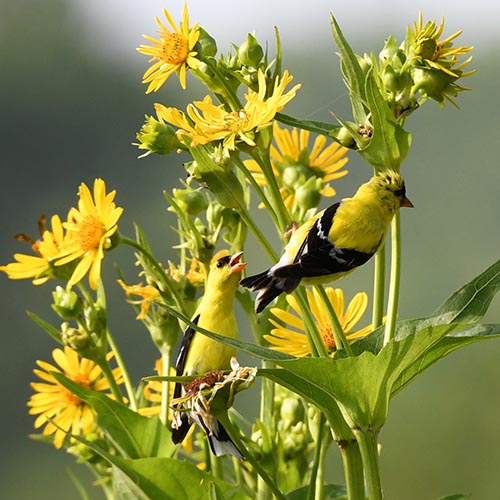
Pair bonding and mating
American goldfinch are often found in loose flocks or colonies. Males and females begin to pair up in the spring. Research suggests that the females use the brightness of the male’s feathers and his bill as signals of his health and suitability as a partner. According to this research, the bright yellow feathers signal his previous health when he was molting into his breeding plumage, while the orange bill, which can change color much faster than the feathers, is a sign of his current health.
Once they form a pair bond, the male and female develop identical flight calls. It is thought that the identical flight calls help them keep track of each other because they’ll still hang out in and travel with the flock or colony.
Even though they begin forming pair bonds relatively early, they don’t start mating right away. Mating and nesting doesn’t begin until mid to late summer, usually sometime in July or August. This is one of the latest starts to the nesting season of any North American songbird and is another way in which American goldfinch are unique. It is thought that their late nesting period developed to take advantage of the abundance of seeds available during this time period.

Nesting
As the nesting season approaches the birds become more territorial. Each pair will visit several potential nesting sites before choosing a shrub to nest in. Female American goldfinches are much more likely than males to return to an area where she had a previously successful nest the year before.
The female builds the nest out of plant fibers, spiderweb silk, and caterpillar silk. She then lines the inside of the nest with the fluffy parts from seeds like milkweeds and thistles. American goldfinch nests are so waterproof when they are complete that they’ll actually hold water.
The female lays an average of 4-6 eggs before incubating them for approximately 2 weeks. The male goldfinch feeds the female as she is incubating. She even has a special call that she uses to greet him as he approaches the nest with food.
After the eggs hatch, both parents feed the nestlings a diet rich in seeds. As the nestlings get older, the female feeds them less and the male feeds them more.
The nestlings typically fledge approximately 2-2.5 weeks after hatching. The male continues to feed the fledglings for several weeks after they leave the nest. Older, more experienced females may attempt a second nest with another male during this time.
Cowbird parasitism
The brown-headed cowbird is a nest parasite. Instead of building its own nest, it lays its eggs in the nests of other bird species. The cowbird egg is then incubated by the nest owner.
When the egg hatches, the cowbird nestling is often larger than the nestlings of the host species. This can have detrimental effects on the other nestlings because the biggest and loudest nestlings get the most food. It’s the old “squeaky wheel” adage in action.
The American goldfinch’s late nesting season reduces the risk of cowbird nest predation because the cowbirds are wrapping up their breeding season as the American goldfinch are getting started. However, the cowbirds aren’t quite done for the season and still lay some eggs in American goldfinch nests.
In a parasitized nest, the American goldfinch female incubates the cowbird egg just like one of her own. When the egg hatches, the parents feed the cowbird nestling just like their own. But the cowbird nestling always dies, usually within the first few days after it hatches.
The reason the cowbird nestlings don’t survive is because of the unique seed-based diet of the American goldfinch nestlings. Cowbirds are like most other seed-eating birds in that their nestlings need the extra protein from an insect-rich diet. However, American goldfinch nestlings get most of their protein from seeds and eat very few insects.
So, it doesn’t matter how much the American goldfinch parents feed the cowbird nestling. It isn’t getting the nutrition it needs to survive. Because most cowbird nestlings die relatively quickly, their goldfinch nestmates are typically able to get enough food to survive and fledge. Brown-headed cowbirds, therefore, have a much lower impact on American goldfinch populations than they have on some other bird species.
Migration
American goldfinch migration can be complicated. Some birds migrate long distances – there are records of birds banded during the summer in Canada being found in Louisiana during the winter. Other birds don’t appear to migrate much at all, especially in the middle part of their range where they can live year-round.
A few general rules appear to exist related to American goldfinch migrations.
- Birds that breed in areas where the average low winter temperature is below 0 °F are more likely to migrate south for the winter.
- Mature females appear to winter further south than males and immature birds.
- Immature birds tend to winter further north than mature males.
During the winter, flocks of American goldfinches will wander over a large range in search of food. Although this wandering doesn’t count as a migration, there is some evidence that winter food availability may also play a role in some seasonal migration patterns.
Attracting and observing American goldfinch
American goldfinches will commonly visit feeders, especially during the winter. They are most likely to be found at feeders with black oil sunflower seeds or Nyjer seeds because of the high oil content found in those seeds. Putting up a feeder is probably the most common way of trying to attract American goldfinch or any other type of songbird.
If you choose to put up feeders, then you’ll need to keep your feeders and the areas around them clean to prevent spreading any potential diseases among your feeder visitors. The Cornell Lab of Ornithology has some great tips for how to clean and care for your feeders.
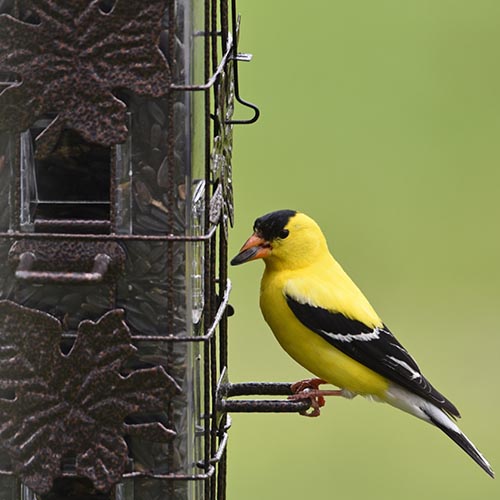
When I was a kid, we primarily used feeders to attract birds and we had your standard mix of traditional landscape plants around the house. We saw goldfinches frequently at the feeders during the winter, but I don’t remember seeing them very often during other times of the year.
Anthony and I no longer put up bird feeders, because we know the chances of us getting busy and forgetting to clean them are too high. So, instead we look for other ways to attract and support birds around our home. That is really easy to do for goldfinches and it has made a world of difference in our goldfinch population.
American goldfinches are one of our most common songbird species on the farm and we see them year-round. I believe a primary reason why they are so common here is because of the habitat and resources we provide, especially when it comes to food sources for them.
Our old fields are full of goldenrods, ironweed, asters, and other members of the aster or composite family which bloom in the late summer and fall. The gardens around the house also have a heavy component of summer and fall blooming plants in the aster family. In addition, the fields and gardens have a wide variety of other plants which produce seeds at other times of the year. And that’s the key to attracting American goldfinches without feeders – always having lots of seeds available.

If you want to attract more American goldfinches to your property, plant a wide variety of native wildflowers and grasses that produce seeds. You want to have seeds available throughout the year, but especially during the late summer and fall nesting season. Examples of these late summer and fall seed producing plants include coneflowers, sunflowers, Silphiums, goldenrods, asters, thistles (yes, we have native thistles), and native warm season grasses.
When you’re planting for American goldfinch, remember that the goldfinches are looking for the seeds. That means you can’t deadhead or cut the flowers off after they stop blooming. In fact, if you leave the seedhead standing all winter, then the goldfinches will continue to come back throughout the winter to look for and eat any remaining seeds.
Also, don’t think that this is an either / or situation. You don’t have to choose between putting up feeders or planting for goldfinch. You can do both. Pick the option or options that work best for you and your current situation. Then enjoy watching the acrobatic, bouncy, balls of feathery sunshine that you attract.
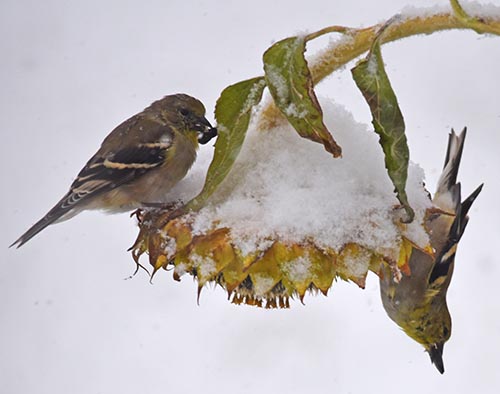
Summary
American goldfinches are beautiful and fascinating songbirds that can be found over most of the continent. Their late nesting season and almost exclusively seed-based diet, even as nestlings, make them unique among our songbirds.
Attracting them to your property is easy. You can simply put out a feeder with either black oil sunflower seeds or Nyjer seeds. Or you can grow lots of native plants that produce seeds, especially in the summer and fall when the goldfinches are nesting. Or you can do both – maintain feeders for them and grow lots of native plants for them. No matter how you choose to attract American goldfinch to your property, you’re sure to have fun watching these vibrant and acrobatic birds.
Incorporating native plants into your landscape is a great way to improve the habitat in your yard for butterflies, hummingbirds, songbirds, and just about every other type of animal that visits your property. If you want to learn more about gardening with native plants, then I’d like to give you a free copy of our e-book, An Introduction to Gardening with Native Plants: Hardiness Zones and Ecoregions.
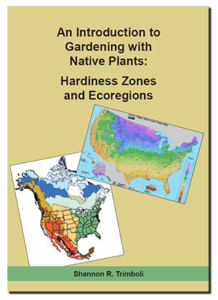
Until next week I encourage you to take some time to explore the nature in your yard and community.

Backyard Ecology: Exploring Nature in Your Backyard
Nature isn’t just “out there.” It’s all around us, including right outside our doors. Hi, my name is Shannon Trimboli, and I am the host of Backyard Ecology. I live in southcentral Kentucky and am a wildlife biologist, educator, author, beekeeper, and owner of a nursery specializing in plants for pollinators and wildlife conservation. I invite you to join me as we ignite our curiosity and natural wonder, explore our yards and communities, and improve our local pollinator and wildlife habitat. Learn more or subscribe to my email list at www.backyardecology.net.

Leave a Reply